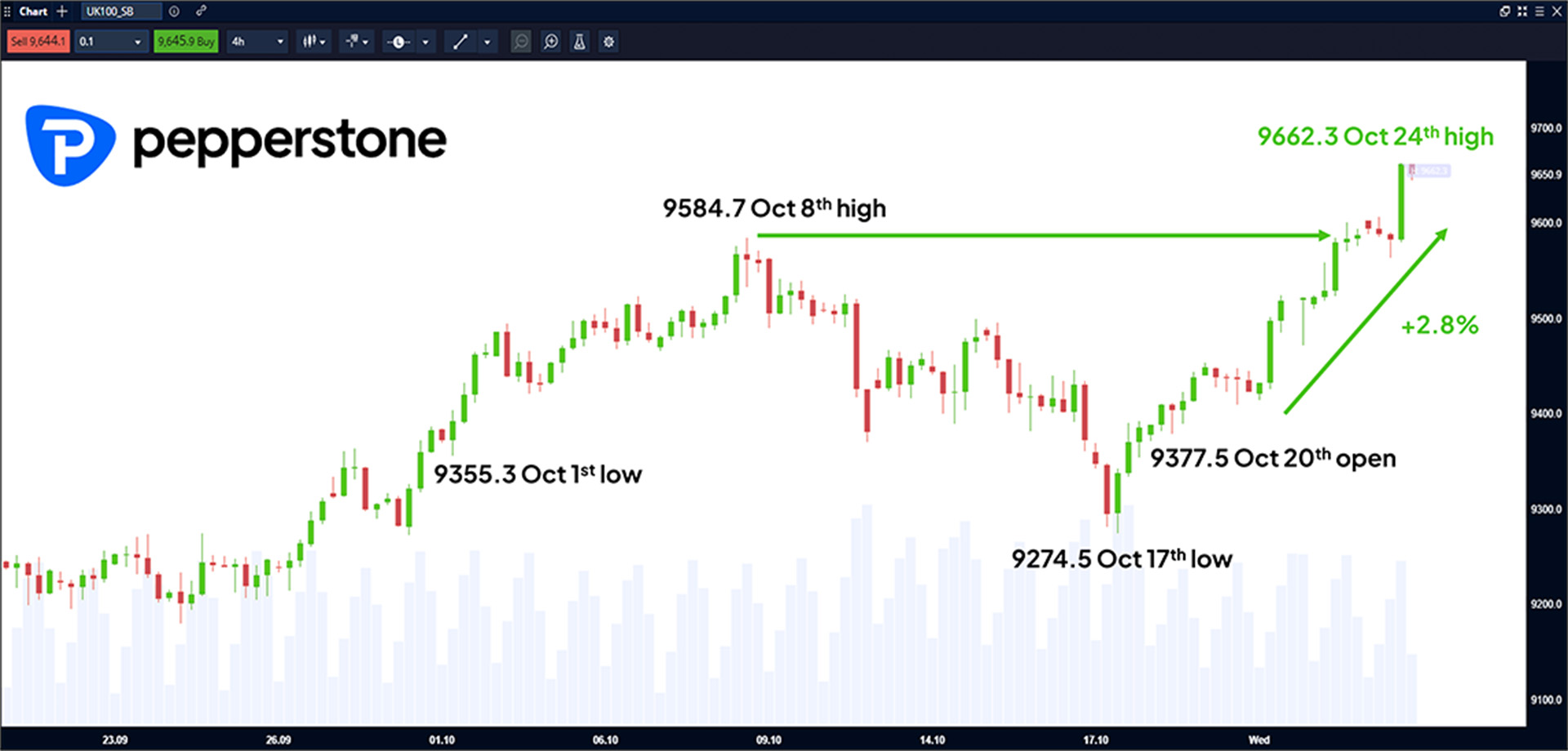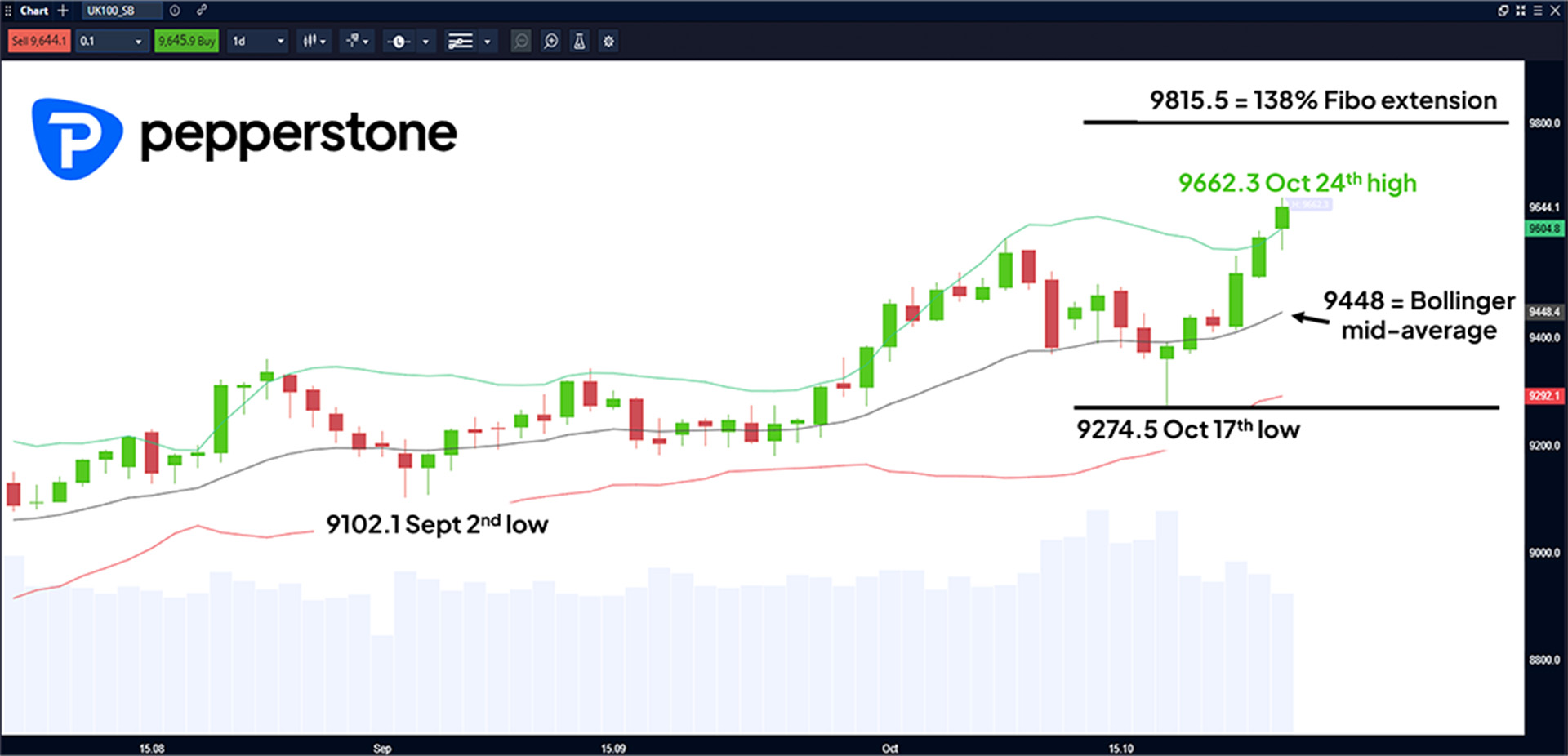Spread bets and CFDs are complex instruments and come with a high risk of losing money rapidly due to leverage. 72% of retail investor accounts lose money when trading spread bets and CFDs with this provider. You should consider whether you understand how spread bets and CFDs work, and whether you can afford to take the high risk of losing your money.
- English (UK)
FTSE 100 at record high with traders watching Fed decision and corporate earnings this week


Summary
- Impact: FTSE 100 traded to a new record high of 9662 on Friday. Closed at 9644, +2.8% on week
- Catalyst: Robust earnings, stronger UK economic data, easing trade tensions, higher oil prices, and lower GBPUSD boost FTSE 100 prices
- Week ahead: Federal Reserve rate decision, President Trump and President Xi meeting, HSBC, Shell and GSK earnings in focus
What is driving the FTSE 100 price?
Strengthening global risk sentiment due to an easing of US-China trade tensions towards the end of last week and the announcement of fresh US and EU sanctions on Russian oil producers and infrastructure providers, which sent oil prices soaring, helped to boost the attractiveness of multinational firms, energy and commodity giants that account for a significant part of the FTSE 100.
More specifically, a largely positive start to earnings season coupled with better-than-expected UK PMI survey readings on Thursday, as well as Friday’s release of a report highlighting that consumer confidence is improving and a surprise rise in retail sales added to the more positive vibe surrounding the current health of the UK economy.
This all helped the FTSE 100 rise 2.8% from its open on Monday October 20th at 9377.5 to post a new record high of 9662.3 on Friday (October 24th), before eventually closing the week slightly lower at 9644, as can be seen on the 4 hourly chart below.

Where next for the FTSE 100?
Maintaining the momentum of this recent up move could be important.
It will be interesting to see how the FTSE 100 responds on the open to weekend comments from President Trump that he is confident of agreeing a new trade deal with China after two days of talks concluded in Malaysia between US and Chinese representatives. President Trump is scheduled to meet Chinese President Xi on Thursday.
The Federal Reserve are also expected to cut interest rates 25bps (0.25%) on Wednesday evening (1800 GMT) and confirm the possibility of a further rate cut at their next meeting in December. The press conference (1830 GMT) led by Chairman Jerome Powell could impact general risk sentiment and the direction of GBPUSD.
Technical update - FTSE 100 daily chart:

As you can see from the daily chart above, FTSE 100 prices broke and closed above the Bollinger mid-average on Monday October 20th with the mid-average starting to rise again into the end of the week indicating the re-emergence of an upside trend. This mid-average currently stands at 9448 and could act as the first support on any dips next week. To the upside, breaks and closes above Friday’s high of 9662.3 could open potential for further upside towards 9815.5, which is the 138% Fibonacci extension level (Oct 17th low to Oct 24th high).
Support: 9448 (Bollinger mid-average), then 9274.5 (October 17th low) then 9102.1 (September 2nd low)
Resistance: 9662.3 (October 24th high), then 9815.5 (138% Fibonacci extension) then 9907.4 (162% extension).
What FTSE 100 stocks are in focus next week?
Earnings of some popular FTSE 100 stocks are due out next week and could impact sentiment.
Highlights:
HSBC which carries the second highest weighting in the FTSE 100 is due to release its earnings before the open on Tuesday.
Shell which carries the third highest weighting is due to release its earnings before the open on Thursday.
Earnings releases:
Anglo American, HSBC (Tuesday)
GlaxoSmithKlein, Glencore, Next (Wednesday)
Shell, Standard Chartered (Thursday)
The material provided here has not been prepared in accordance with legal requirements designed to promote the independence of investment research and as such is considered to be a marketing communication. Whilst it is not subject to any prohibition on dealing ahead of the dissemination of investment research we will not seek to take any advantage before providing it to our clients. Pepperstone doesn’t represent that the material provided here is accurate, current or complete, and therefore shouldn’t be relied upon as such. The information, whether from a third party or not, isn’t to be considered as a recommendation; or an offer to buy or sell; or the solicitation of an offer to buy or sell any security, financial product or instrument; or to participate in any particular trading strategy. It does not take into account readers’ financial situation or investment objectives. We advise any readers of this content to seek their own advice. Without the approval of Pepperstone, reproduction or redistribution of this information isn’t permitted.